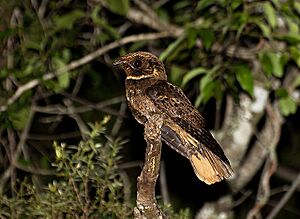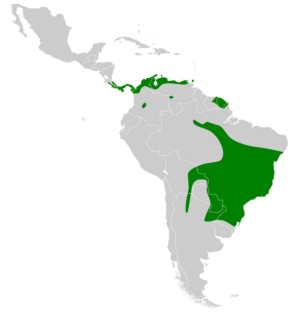Rufous nightjar facts for kids
Quick facts for kids Rufous nightjar |
|
|---|---|
 |
|
| Conservation status | |
| Scientific classification | |
| Genus: |
Antrostomus
|
| Species: |
rufus
|
 |
|
| Synonyms | |
|
Caprimulgus rufus |
|
The rufous nightjar (Antrostomus rufus) is a fascinating bird. It is part of the nightjar family, known for being active at dawn and dusk. You can find this bird in many countries across Central and South America. These include places like Brazil, Argentina, Colombia, and Venezuela. It also lives on the island of Saint Lucia.
Contents
About the Rufous Nightjar's Name
Scientists give every living thing a special name. This helps everyone know exactly which animal they are talking about. The rufous nightjar's scientific name is Antrostomus rufus.
The first part, Antrostomus, comes from ancient Greek words. Antron means "cavern" and stoma means "mouth." This might refer to the bird's wide mouth, which is great for catching insects. The second part, rufus, is a Latin word meaning "red." This describes the bird's reddish-brown feathers.
There are a few different types of rufous nightjars. Scientists call these "subspecies." They are all very similar but have small differences. Some scientists recognize four subspecies, while others might recognize five.
The main subspecies are:
- A. r. minimus
- A. r. rufus
- A. r. otiosus
- A. r. rutilus
- A. r. saltarius
What Does the Rufous Nightjar Look Like?
The rufous nightjar is about 25 to 30 centimeters (10 to 12 inches) long. It weighs around 88 to 98 grams (about 3 to 3.5 ounces). This bird is mostly reddish-brown all over.
It has a light brown collar around its neck. There is also a white band under its throat. Its upper feathers have dark brown stripes. The wings have dark brown spots and bars. The feathers on its belly are speckled with dark brown and white.
Unlike many other nightjars, this bird does not have white on its wings. Male rufous nightjars have a large white spot on the tips of their outer tail feathers. Females have pale buff (light yellowish-brown) tips on their tail feathers instead. The different subspecies might have slightly different colors or speckle patterns. One subspecies, A. r. saltarius, looks much grayer than the others.
Where the Rufous Nightjar Lives
The rufous nightjar lives in many different places, but its population is spread out. Each subspecies lives in specific areas:
- A. r. minimus lives in southern Costa Rica, Panama, and along the Caribbean coasts of Colombia and Venezuela. It is also found in Trinidad.
- A. r. rufus lives in parts of eastern Venezuela, Guyana, Suriname, and central Brazil.
- A. r. otiosus is found only on the island of St. Lucia in the Lesser Antilles.
- A. r. rutilus lives in southeastern Bolivia and central Brazil. Its range extends south to Paraguay and northeastern Argentina.
- A. r. saltarius is found in southern Bolivia and northwestern Argentina.
Scientists also believe this bird lives in Ecuador and Peru. The rufous nightjar lives in many different types of places. These include dry scrublands and both old and new forests. They can be found in dry areas like the Gran Chaco or humid places like the Amazon basin.
Behavior and Habits
The rufous nightjar is most active when the sun is rising or setting. This is called being "crepuscular." During the day, it rests quietly. It might perch on a low branch or hide on the ground. It often chooses a spot under thick plants to stay hidden.
Feeding Habits
The rufous nightjar hunts for food by flying out from a low perch. This could be a branch or a fencepost. It mostly eats insects. Scientists are still learning more about the exact types of insects it prefers.
Reproduction and Life Cycle
Rufous nightjars do not build a fancy nest. Instead, the female lays her eggs directly on the bare ground. She usually lays one or two eggs. These eggs are often hidden among low plants to keep them safe. The female bird sits on the eggs during the day to keep them warm.
Vocalization
The rufous nightjar has a very distinct song. People describe it in different ways. Some say it sounds like "a loud, staccato chup, whi-whi-RIoh." Others hear it as "a rhythmic chuck, wick-wick-WEEoo." The bird usually sings from a perch. This perch can be anywhere from the ground up to 20 meters (65 feet) high.
Conservation Status
The International Union for Conservation of Nature (IUCN) checks on animals around the world. They have listed the rufous nightjar as a species of "Least Concern." This means it is not currently in danger of disappearing. It lives in a very large area, and there are many of these birds. However, scientists believe its population might be slowly decreasing. Right now, there are no big threats that worry scientists.


